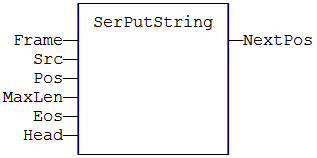SerPutString
Function - Copies a string to a binary frame
Inputs
|
Input |
Data type |
Description |
|
FRAME |
USINT |
Destination buffer - must be an array. |
|
DST |
STRING |
Source variable to be copied. |
|
POS |
DINT |
Position in the source buffer. |
|
MAXLEN |
DINT |
Specifies a fixed length string. |
|
EOS |
BOOL |
Specifies a null terminated string. |
|
HEAD |
BOOL |
Specifies a string headed with its length. |
Outputs
|
Output |
Data type |
Description |
|
NEXTPOS |
DINT |
Position in the destination buffer after the copied data. |
Remarks
This function is commonly used for storing data to a communication frame.
In LD language, the operation is executed only if the input rung (EN) is TRUE. The output rung (ENO) keeps the same value as the input rung.
The FRAME input must fit the input position and data size. If the value cannot be safely copied, the function returns 0.
The function copies the following bytes to the frame:
|
MAXLEN |
EOS |
HEAD |
Description |
|
<> 0 |
any |
any |
The string is stored on a fixed length specified by MAXLEN. If the string is actually smaller, the space is completed with null bytes. If the string is longer, it is truncated. |
|
= 0 |
TRUE |
any |
The string is stored with its actual length and terminated by anull byte. |
|
= 0 |
FALSE |
TRUE |
The string is stored with its actual length and preceded by its length stored on one byte. |
|
=0 |
FALSE |
FALSE |
invalid call |
The function returns the position in the source frame, after the stored data. Thus the return value can be used as a position for the next serialization.
ST Language
Q := SerPutString (FRAME, DSR, POS, MAXLEN, EOS, HEAD);
FBD Language

LD Language
The function is executed only if EN is TRUE.
ENO keeps the same value as EN.

SerPutString |
|
IEC 61131-3 Automation platform > Programming - Reference guide > Advanced operations > SerPutString |
Created with the Personal Edition of HelpNDoc: Make Help Documentation a Breeze with a Help Authoring Tool

